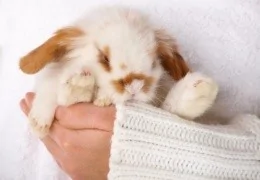With its roots in the vast Pampa, the Uruguayan Maroon breed is extremely strong. It is a dog that is a survivor,...
MY HAMSTER HAS ESCAPED, WHAT CAN I DO?
INTRODUCTION
Hamsters are animals that love to explore, but sometimes they run away and finding them can be a headache.
WHAT CAN I DO IF MY HAMSTER HAS ESCAPED FROM ITS ENCLOSURE?
The first thing to do is to stay calm, the loss of a small hamster can be a very stressful situation if you can't keep your nerves in check. The chances are that you will find him sooner or later, and that he will be fine. The calmer you are, the better you will be at finding him. If the room in which he was lost was sealed: all its doors and windows closed, make sure it stays that way and make sure that whoever enters or leaves does so quickly and keeps an eye on his feet.
Unfortunately, the greatest danger of a hamster running loose in the house is that you or your family members will inadvertently crush it. A hamster's body is very vulnerable, and we humans are immensely large and strong compared to them, so an inadvertent stomp on the hamster's foot, or sitting on the sofa without first checking that it is not there, can be the most likely fatal outcome. So if you and those around you are careful, you are already tackling a huge number of deadly dangers.
The secret to undertaking any search is to maintain scrupulous order. Comb from top to bottom the room where the hamster was lost, i.e. where you last saw it. When it is completely checked, leave it closed and go on to check the next one, and so on with all the rooms, one by one you must close them so that the animal does not go from one to another after you.
TRICKS TO FIND MY LOST HAMSTER
The first thing the hamster will miss once it gets lost (or escapes) is food and water. We must use that need to find him. Place a large piece of aluminium foil in the centre of each room that has already been checked, and in the centre its favourite food, and in a circle around the food, paint the foil with flour. The idea is that the hamster will want to eat, it will approach its food, but in the process it will stomp on the foil and you will be able to hear the sound, but even if you don't hear it, the hamster will leave traces with its little paws as it soaks them in flour and stomps on the foil and the floor. You will then know which room the hamster is in, and you can discard the idea of looking in other rooms.
Rodents are nocturnal animals, they are programmed to forage for food at night for survival, to protect themselves in the dark from predators. For this reason, bear in mind that any trap or strategy you put in place to catch them will work better, or be more likely to work, if you put it into practice at night. It is not enough to lower the blinds, hamsters have a biological clock that tends to tell them what time it is, it is not only guided by the level of darkness.
If you put a little flour around the seeds or in front of some suspicious hiding places you can follow the trail of small footprints to give you an idea of where he might be hiding.
HOW DO YOU PREVENT IT FROM ESCAPING FROM ITS ENCLOSURE?
The first thing is to have a suitable habitat for your hamster. Traditional cages with bars are not suitable, neither is a habitat that is too small (it would add more stress), neither are fabric parks, nor cardboard, nor using very thin plastic that can easily break or making very large breathing holes where it can reach without putting chicken wire.
Doors should be placed on the lid, if it is on the side it would be better to put a sliding lock to prevent it from escaping.
If we let him out into a larger enclosure or room, we must make sure that there are no gaps, holes or furniture where he can get in and get lost, so the best option is the bathroom and always under supervision.
ADVICE FOR VISITORS AND CHILDREN
In the case of visitors, if they are children, repeat several times that they should not open the doors of the enclosure or take the hamster without permission or without an adult present. Mentally mature and responsible children will understand this at first, but children are children and the best thing to do in these cases is to put a sliding lock at the top of the door where our hamster is kept to prevent it from entering and for them not to reach it. Not only because it can get lost but also because if the hamster falls (when catching it or because it gets scared, bites and hits itself) it can suffer a lot of damage and even die.
CONCLUSION
Hamsters make excellent pets, but some are masters of escape. These rodents have a strong natural instinct for scurrying to keep themselves safe from predators. They often prefer a spot behind the refrigerator or other hard-to-reach spaces. Fortunately, you can keep your pet safe and happy by channelling its energy into more positive activities, choosing the most appropriate cage and planning ahead for the possibility of an escape.
Leave a comment
Log in to post comments
















